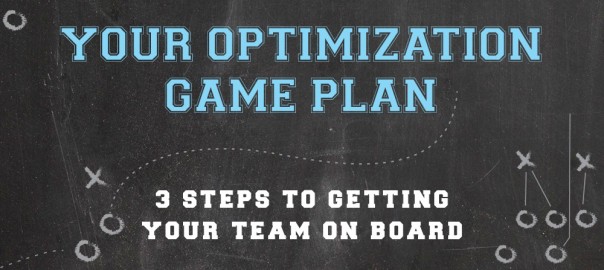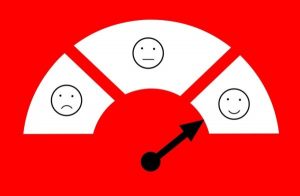
If you’re taking the time to read this article, you are probably already on board with testing and optimization. The trick is to convince other key players within your organization to get on the bus, right? In order to do so, you must think of testing as a team sport, rather than an individual effort.
In 2015, an increasing number of companies have a grasp on the critical value of testing and optimization. For most, however, it’s not a question of whether to do A/B and multivariate testing, but rather how to convince everyone to pitch in with the effort. How do you garner the proper buy-in across all departments? This is so crucial to ensuring success from your optimization work.
Based on what we’ve learned from making this a reality at our own agency and for many of our clients, here’s a 3-step game plan we’ve seen work wonders. At the end, we share some insight from our personal journey.

1. Team Kick-off for Testing Success
Get everyone on the field.
If you had a football team, you wouldn’t go up against the Seattle Seahawks without a strong QB and a rock solid offensive line to back him up. You’d probably also need some quality defense and Special Teams on your side, too. The same principle applies to testing.
Remember, every position is vital and needs to be represented on the field. When you bring on multiple departments, you’re adding unique viewpoints and agendas — but this is a good thing because it balances your own biased agenda.
Use testing briefs.
These are shared documents that delineate common knowledge and goals along with objective hypotheses and testing plans. They also include measurement and timing information. This is important because it helps aligns the organization to both a plan and a goal.
Begin at the beginning.
Always build testing into the IA (Information Architecture) and Content Strategy process. During the IA and content creation process, there are a lot of assumptions being made.
By leveraging the discovery you are doing already during the IA phase, you can identify high-risk or ambiguous opportunities that are ripe for testing. By taking advantage of this, you mitigate risk within the project.
Be future forward.
While going through the process of design, it is very easy to be focused on the end prize. Do yourself a favor and think about what information will be helpful for you to have on hand when evaluating the end product. You’ll want to dedicate a place to store results and validate hypotheses for future use. Also, make sure to revisit them often.
Get out of your silos.
This is probably the biggest piece of advice we can share. The key here is to decentralize testing/optimization as a business unit but utilize subject matter experts. A single person (or department) will have difficulty scaling testing and optimization across an organization unless it’s really small. Even more important: empower the people that know more than you. These include product managers, business unit leaders, actual teams that interact with your customers. Get their hypotheses into the mix.
Don’t forget the tech.
Plan for testing in advance, well before starting a project. Consider creating entirely unique landing pages or variations within pages, such as headlines, CTAs and images. Also, getting your technical team on board will help you avoid pitfalls in the future.
2. Thoroughly Plan Your Testing

It’s pretty clear that if you don’t properly plan and execute your tests the first time around, they might not deliver the impact the client is expecting, and no one wants a dissatisfied client. If testing was a hard sell to begin with, be strategic with your first few tests to win the client over completely. If you work for a cutting edge team that just gets it, you’re a lot freer to go for the Hail Mary pass.
A little goes a long way.
Even a little research will make for much better, faster, more focused testing and better results, sooner. Research will help formulate more focused hypotheses and a more impactful testing plan. In turn, you will see better results at a quicker rate.
Know when to start and start small.
Dip your toe in the testing pool when client has huge potential for increases in conversion. Start with A/B testing of single variables and work your way up. Multivariate testing is great, but it’s only useful if you’re able to interpret results.
Make it testable.
Form hypotheses that are testable, have goals of solving conversion problems, and gaining market insights. Also, make sure you are getting actionable data from analytics.
For real insights, forget about averages: In your testing, did you add an element that was wildly successful with a small, niche market segment? You might be on the right track. Examine test performance for different customer segments to tease out insights.
Let go of your agenda.
The key value of testing is to learn what you don’t know, not to prove yourself right.
3. Prioritize for results

Companies respond to success. Many companies, however, start out pumped up to perform testing and optimization only to scale back their efforts when they don’t see the results they’d hoped for. Avoid this by continually brainstorming testing ideas. Host a testing hackathon. Secure some easy, early wins. But also don’t settle for simply testing button colors. Prioritize what you test to ensure you’re not wasting time on mediocre ideas.
Get some bang for your buck.
Prioritize pages and test the ones with highest impact first. Contrary to what many think, the highest potential doesn’t usually exist on the homepage. Look, instead, to most visited pages, top landing (entry) pages and pages with the most expensive exits. Here’s an example of a non-biased method of prioritizing A/B test ideas.
Make it a balancing act.
Understand the balance of prioritization by looking at pages through multiple lenses. Does this page have high conversion opportunity? Is it key to our end goals? Is it simple to test?
How We Did It
As a digital marketing agency, we went through an evolution on our roadmap to creating a culture of optimization. We probably started a lot like you, focusing on optimizing conversions for specific marketing campaign landing pages. At the time, these efforts were siloed in the direct response marketing and analytics/measurement side of the business. Yes, we saw some success, but we sensed potential for even greater impact. Here’s what we did:
- We brought the idea of integrating testing throughout the organization to our company’s executive leadership.
- With top-level buy-in, we created a task force which included members of the strategy, development, creative services, marketing, and analytics teams.
- We then assigned the project an executive sponsor, which allowed us to integrate it into other areas of the business for value beyond just conversion rates.
- Once we developed and solidified the proof of concept internally, we had a strong foundation to extend the strategies to our clients.
We have been able to demonstrate to our clients that letting the end user pick the winner versus simply letting the strongest opinion win out was a more strategic way to approach a digital campaign. This has opened the doors to exploring designs that display thought leadership and teeing up ideas that would have originally been viewed as too risky.
Just like in sports, practice makes perfect. Yes, it takes time, but the results will speak for themselves. And we can report some of the biggest initial skeptics have turned into advocates – both within our agency and with our clients – when they were included early on in developing the plan.
(177)






